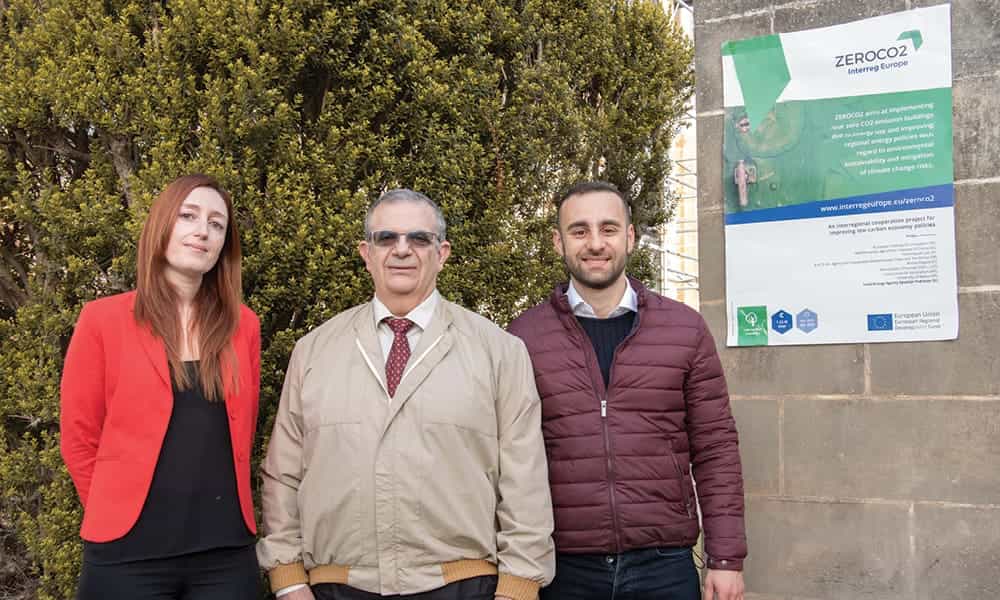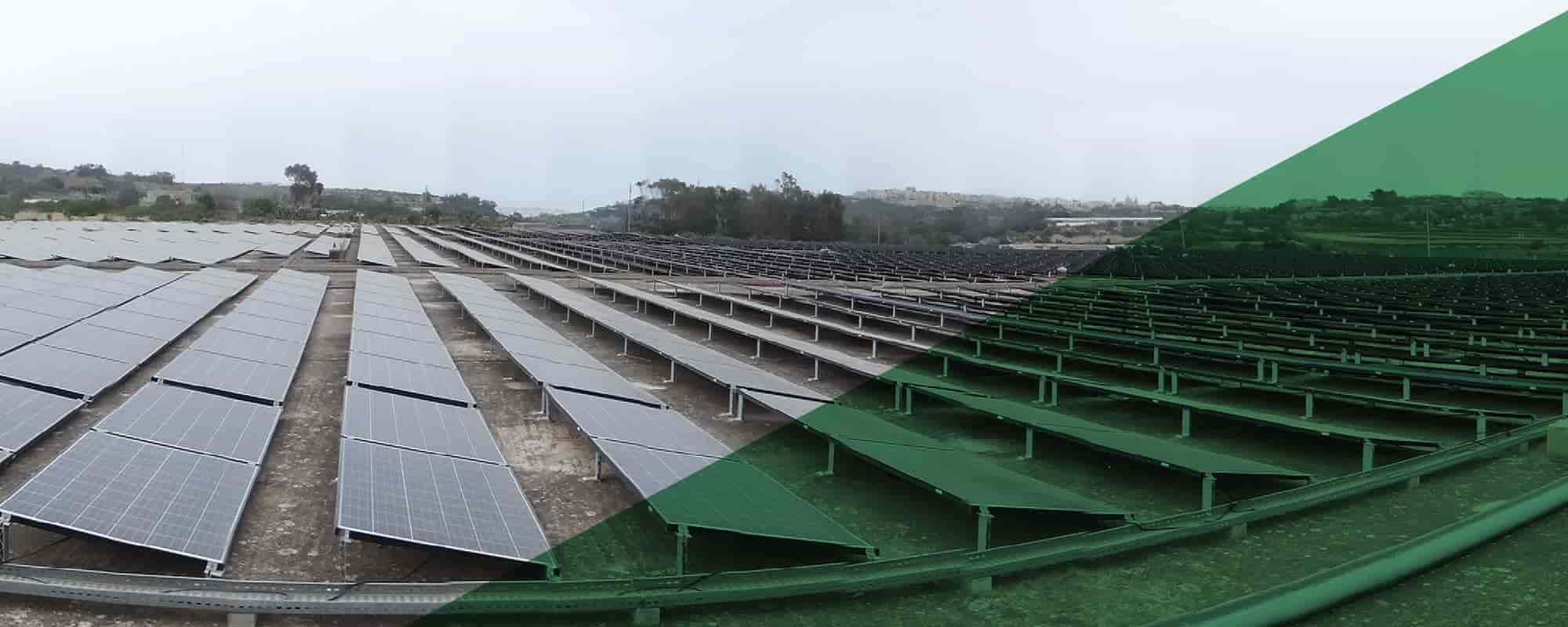There is more to making a building energy efficient than simply installing PV Panels. To create a truly zero-energy building, a holistic approach involving engineers, architects, and builders needs to be taken. THINK sits with Prof. Ing. Charles Yousif and his team to see what such an approach looks like.
The Interreg Europe Project ZEROCO2, led by Prof. Ing. Charles Yousif, aims to identify energy policy measures that can accelerate the implementation of the EU Energy Performance of Buildings Directive. The ultimate goal of these policies is to push us closer towards near zero CO2 emission buildings. But before we go any further, we need to clarify what zero CO2 emission buildings are. Ing. Krista Rizzo, a research support officer for the project, explains: ‘The EU’s definition of “zero emissions” is one that focuses on energy efficiency first. Once energy usage is reduced as much as possible, the remaining energy should come from renewable sources.’ Simply put, it is not enough to create green energy, but rather our buildings need to be more efficient, minimising the amount of energy wasted in the first place.
WHY ZEROCO2 BUILDINGS?
The COVID-19 pandemic and the surge in gas prices has thrown our dependency on fossil fuels into the spotlight. The invasion of Ukraine and supply chain issues have caused the price of gas, one of the main methods to heat homes and generate electricity in mainland Europe, to spike. As an example, because of this, over three million low-income households in the UK could not afford to heat their homes this winter. This, coupled with the threat of rapid climate change, has forced many nations to rethink their energy strategy.
While the ZEROCO2 project originally started in 2016 and was concluded in March 2020, the team secured funding from the Interreg Europe Fifth Call for an additional year to September 2022, focusing on the impact of COVID-19 on achieving energy efficiency in buildings. The project is being led by the Local Energy Agency Spodnje Podravje in Slovenia and has seven partners from Malta, Germany, France, Italy, Greece, Finland and Lithuania.
‘We realised that a number of regions (from international partners in the project), including Malta, have issues with indoor air quality. They do not have clear regulations with regards to minimum fresh air requirements in public buildings such as schools, offices, and so on. This was the direct link between the project and COVID-19. Given that COVID-19 is an airborne virus, the lack of proper ventilation increases the risk of transmission,’ Yousif explains. Rizzo also points out that ‘when designing zero CO2 buildings, we also need to make sure that indoor air quality is catered for. These spaces should be healthy and comfortable besides being energy efficient.’

Photo by James Moffett
AN INTEGRATED APPROACH
When it comes to designing a zero carbon building, the team advocates for an integrated approach. A zero CO2 building is about more than just reducing your energy bill; it encompasses comfort, indoor air quality, and well-being, as well as energy stability. The latter point is especially relevant in the wake of the invasion of Ukraine and inflated energy prices.
‘It is not enough to simply install PV panels and call it a day. First, you consider the building envelope (the physical barriers between the indoor and outdoor environment), then the energy services within the buildings, until finally moving on to renewable energy sources,’ Rizzo elaborates. Installing PV Panels is rather pointless if you are still losing energy through inefficient insulation!
Dr Ing. Damien Gatt, a systems engineer employed at the Institute for Sustainable Energy, who was also involved in the project, takes this a step further: ‘When installing renewable energy systems, grid integration and load-matching capabilities also need to be considered. Nearly zero CO2 buildings need to be assessed not only by indicators for total energy consumption and generation, but using a multiple-indicator approach that gives weighting to aspects such as the building envelope quality, comfort, indoor air quality, and load matching.’ Yousif and Gatt already proposed such an approach for a social housing block in Malta in September 2020.
Yousif makes it clear that for an integrated approach, ‘designers, architects, structural engineers, and building system engineers need to work together from the start.’ However, such an approach is still not fully put into practice within the Maltese context. The first step is introducing the right policies and tools.
POLICY RECOMMENDATIONS
Gatt explains how ‘a shift in mentality from the classic design approach to the described integrated design approach is required. This kind of thinking does not stop at the construction stage but also evaluates post-occupancy building performance. Various tools facilitate the application of the integrated design approach, including building information modelling and building energy modelling. To meet the requirements of high-performance buildings, these tools must become the norm in any design project. ’After numerous discussions with the project partners, the team developed four energy policy recommendations that can be implemented locally:
- Legislation for indoor air quality and ventilation
- Energy consumption awareness through improved access to smart meter data
- Benchmarking of buildings through statistical analysis of energy performance certificates (EPCs)
- Provision of support to consumers and professionals through an energy one-stop shop
We’ve already touched upon the importance of proper legislation. Locally, we do not have clearly defined legislation to control indoor air quality. While there are several international standards that architects and engineers can refer to, it is still up to the designers to follow these standards. Furthermore, standards are not mandatory. Rizzo goes further and explains, ‘The project is working with the key stakeholder, the Malta Competition and Consumer Affairs Authority, to kickstart this process. Standards and legislation need to take local conditions into account.’ For example, mould and humidity are significant issues for local dwellings. With the right legislation, it is possible to reduce mould by enforcing proper ventilation.
While smart electricity meters have existed for a while, they tend to fall short of their full potential. Yousif mentions how ‘one of the energy policy recommendations of the project calls for an increase in people’s awareness of energy consumption. Consumers need to know how much energy is being wasted before convincing them to change. By enabling access to one’s own smart electricity meter data in real time (either through a mobile app or the internet), consumers will be able to better understand their consumption habits and begin tackling them. The Water Services Corporation has already embarked on a similar initiative for water consumption; the system even sends you an SMS when a sudden change in water consumption pattern is registered, possibly indicating a leakage.’ Adopting such an approach to electricity systems is simply the next logical step. After all, what cannot be measured cannot be improved.
Local homeowners are probably already aware of EPCs. Currently, citizens consider EPCs as another form of bureaucratic paperwork when purchasing a dwelling. The real purpose of EPCs is to help consumers make an informed decision on the energy performance of their dwelling. Ironically, a log-book for your vehicle allows you to see a history of the car’s services and performance, while a house or an apartment (both significantly larger investments) does not have such records. Besides being used to determine how energy efficient a dwelling is, EPCs could have a much wider impact. ‘There are over 80,000 EPCs lying in MITA servers. EPCs could be used to develop benchmarks on energy performance of different building categories. This data would allow the relevant authorities to start renovating the worst polluters first and provide valuable information for potential buyers to opt for more efficient properties – ones that have lower energy consumption than the benchmarks,’ explains Yousif.
Finally, a one-stop shop for energy efficiency in buildings would allow both consumers and professionals a centralised point of contact. ‘This one-stop shop would help guide consumers through their renovation process, providing unbiased information. It would also help technical staff by providing courses and answers to FAQs on the latest legislation and available relevant studies. France has already adopted a similar approach known as “France Renov”,’ Rizzo points out. Yousif agrees, ‘Malta is already quite adept at one-stop shops, for example BusinessFirst and MyHealth are two very successful one-stop shops for business and health, respectively.’ However, Yousif makes an astute observation: ‘locally, there is a need for better harmonisation, as building energy performance, renewable energy, and fiscal grants are not dealt with by one entity but by several.’
A BETTER FUTURE?
When an entity such as the University of Malta or any institute embarks upon a research project, there are more than just researchers working on it. In the background, there are several other players that support these projects. The team behind ZEROCO2 would like to acknowledge the support received from the University’s Project Support Office, the Research Support Services Directorate, the Finance Office, the Corporate Research and Knowledge Transfer Office, and the Legal Office. The team is also pleased to announce that the University of Malta has just been granted funding for a new Interreg Europe proposal entitled ‘Decarbonising the Tourism Industry Post Covid-19 Support’ (DETOCS), which builds on the ZEROCO2 project and will be carried out in collaboration with some of its partners and the Ministry for Tourism.
While researchers have laid the groundwork for more energy efficient buildings, it is now up to legislators to implement the appropriate framework. Fundamentally, this research goes beyond energy efficiency. It is about becoming future-proof. The COVID-19 pandemic and, more recently, the invasion of Ukraine have highlighted just how fragile our systems are. We need to be prepared for whatever the future may hold in store.
Further Reading:
Gatt, D., Caruana, C., & Yousif, C. Building Energy Renovation and Smart Integration of Renewables in a Social Housing Block Toward Nearly-Zero Energy Status. doi:https://doi.org/10.3389/fenrg.2020.560892






Comments are closed for this article!